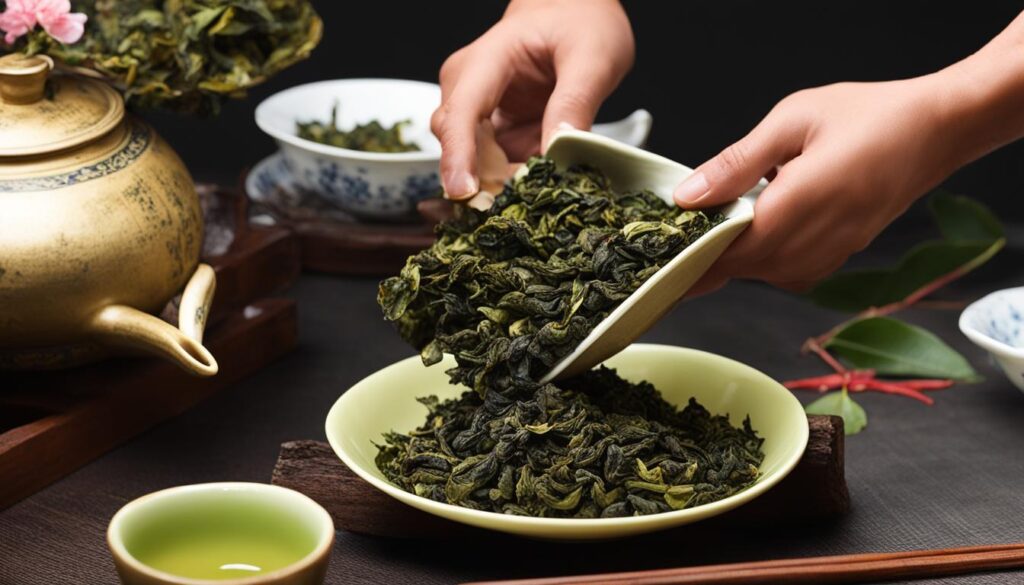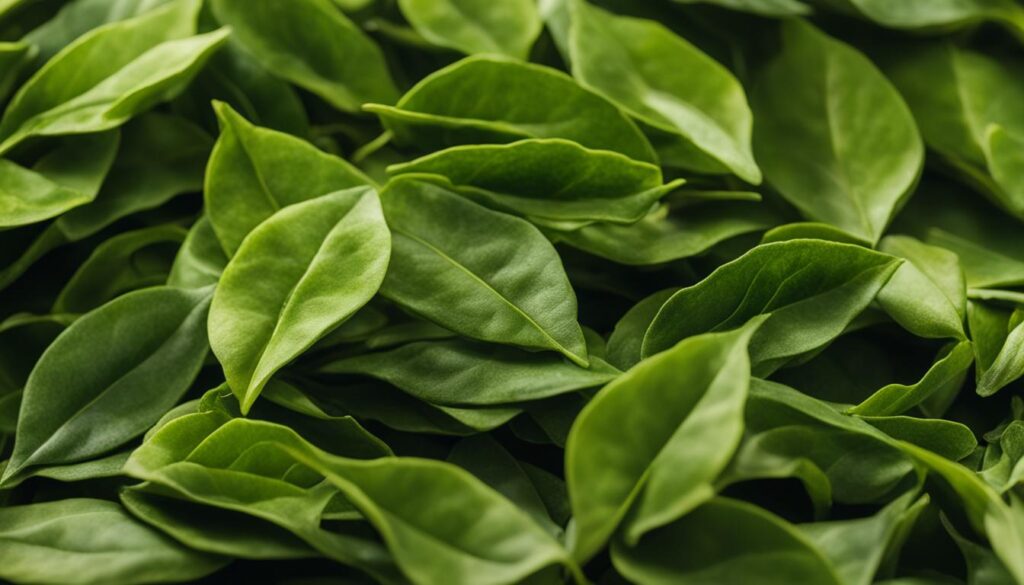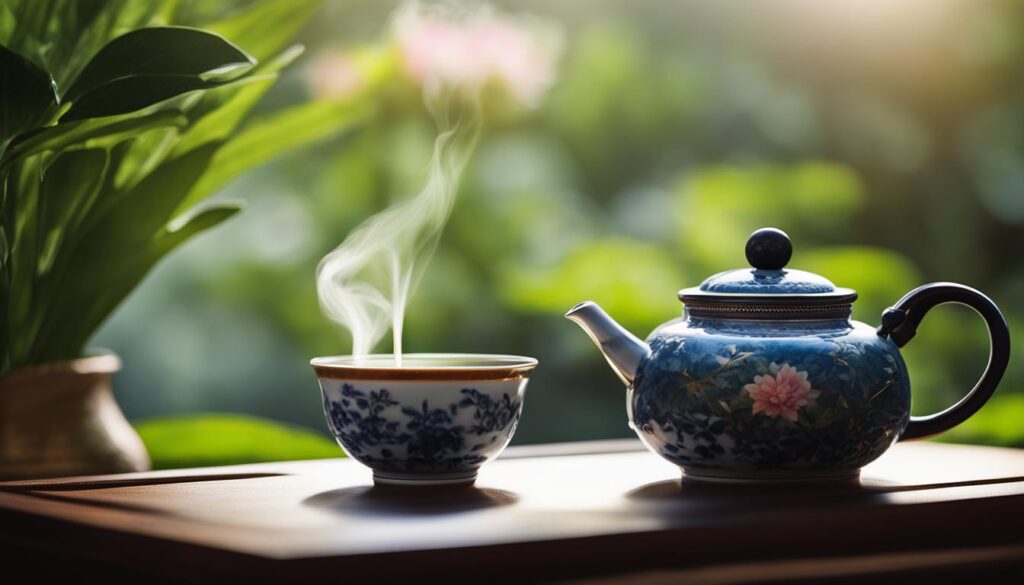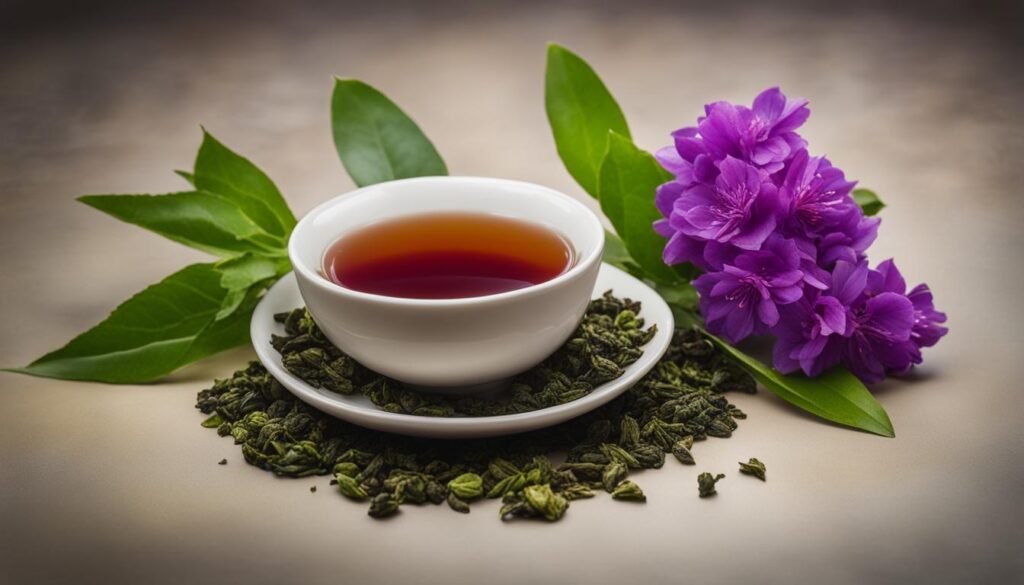Tieguanyin, also known as “Iron Goddess of Mercy,” is a traditional Chinese oolong tea with various health benefits. The tightly rolled brown-green leaves of Tieguanyin have a soft woodsy aroma that transforms into a greener scent with a light floral note upon brewing. This tea is renowned for its acidity and smoky, floral, and fruity tones. Legend has it that Tieguanyin tea was a gift from a compassionate goddess and became a favorite of the Emperor and one of China’s most famous teas.
Key Takeaways:
- Tieguanyin tea, also known as “Iron Goddess of Mercy,” is a traditional Chinese oolong tea.
- Tieguanyin has a unique aroma and flavor profile with smoky, floral, and fruity tones.
- Legend has it that Tieguanyin tea was a gift from a compassionate goddess.
- Tieguanyin tea is famous for its health benefits and is considered one of China’s most famous teas.
- This article will explore the unique processing, different varieties, brewing instructions, health benefits, and legends behind Tieguanyin tea.
The Unique Processing of Tieguanyin Tea
Tieguanyin tea, also known as “Iron Goddess of Mercy,” undergoes a unique and intricate processing method that contributes to its exceptional taste and aroma. The tea production process involves several stages, each meticulously executed to bring out the true character of this revered oolong tea.
- Plucking tea leaves: The first step in Tieguanyin tea processing is carefully selecting and plucking the tea leaves, ensuring only the finest and most tender leaves are used.
- Sun withering: After plucking, the tea leaves are spread out in the sun to wither, allowing them to lose moisture and develop their distinct flavor profile.
- Cooling: Once the leaves have undergone sun withering, they are cooled down to halt the oxidation process and preserve their freshness.
- Tossing: Tossing is a critical step where the tea leaves are gently shaken to bruise the edges, accelerating oxidation and enhancing the tea’s aroma and taste.
- Withering: Following tossing, the leaves are allowed to wither further, ensuring optimal oxidation and flavor development.
- Fixation: Fixation involves heating the leaves to stop oxidation and preserve their unique characteristics. This step is crucial in maintaining the tea’s exquisite taste.
- Rolling: The tea leaves are carefully rolled into tight, compact shapes, transforming their appearance and enhancing the release of flavor during brewing.
- Drying: The final step in Tieguanyin tea processing is drying. The leaves are subjected to controlled heat, removing any remaining moisture and ensuring their longevity.
The intriguing aspect of the Tieguanyin tea processing method is the secrecy surrounding it. Tea producers often keep their specific techniques and proportions undisclosed, adding to the allure and mystique associated with this renowned oolong tea.
“The unique processing method of Tieguanyin tea delicately enhances its flavor and aroma, making it a coveted choice among tea connoisseurs.”

Continue reading to explore the different varieties and harvest times of Tieguanyin tea.
The Different Varieties and Harvest Times of Tieguanyin Tea
Tieguanyin tea offers a diverse range of varieties based on the harvest time, each with its own unique characteristics and flavors. Let’s explore the different varieties of this renowned Chinese oolong tea:
1. Spring Tieguanyin
Spring Tieguanyin is considered the most prized variety, harvested around the start of summer, resulting in the highest quality tea. It is known for its delicate floral aroma, smooth texture, and balanced flavors. The leaves are carefully plucked during this season to capture the tea’s finest qualities.
2. Autumn Tieguanyin
Autumn Tieguanyin is harvested later in the year, offering a strong and aromatic cup but with a less complex taste compared to Spring Tieguanyin. While it may lack the same level of intricacy, Autumn Tieguanyin still provides a satisfying tea experience.
3. Summer Tieguanyin
Harvested during the summer months, Summer Tieguanyin tea is typically of lower quality compared to the spring and autumn varieties. It can be further divided into two types based on the specific month of harvest. Despite being less revered, Summer Tieguanyin still offers pleasant flavors and aromas.
4. Winter Tieguanyin
Winter Tieguanyin has limited production as it is harvested during the winter months. The cold weather conditions during this season create a unique flavor profile, often with a more robust character. While not as commonly available as the other varieties, Winter Tieguanyin provides a distinct tea experience for those fortunate enough to enjoy it.

Each season brings its own nuances and qualities to Tieguanyin tea. Whether you prefer the delicate and fragrant Spring variety or the robust and distinctive flavors of Winter Tieguanyin, exploring the different varieties allows tea enthusiasts to discover their personal favorite within this beloved oolong tea category.
Brewing Instructions for Tieguanyin Tea
To fully enjoy the rich flavors of Tieguanyin Tea, it is essential to follow the proper brewing instructions. Here are the steps to brew a perfect cup of Tieguanyin Tea:
Gather Your Brewing Tools
Before you begin, make sure you have the necessary brewing tools. These can include cups, bottles, tea wares, or tea bags, depending on your preference.
Water Temperature
To bring out the best flavors of Tieguanyin Tea, it is crucial to use water at the right temperature. The recommended water temperature for brewing Tieguanyin Tea is 207°F. This temperature allows for optimal extraction of the tea’s flavors and aromas.
Measure the Tea
For a satisfying cup of Tieguanyin Tea, it’s important to use the correct amount of tea leaves. The suggested amount is 1-1½ teaspoons of tea for every 6-10 ounces of water. Adjust the amount according to your preference for a stronger or milder flavor.
Steeping Time
When brewing Tieguanyin Tea, the steeping time plays a crucial role in achieving the desired flavor profile. For the initial steep, allow the tea to steep for approximately 20-30 seconds. Subsequent infusions may require longer steeping times of 30-50 seconds. To avoid any bitterness, it is recommended to keep the infusion time between 10-20 seconds.
Drinking Tips
To fully appreciate the flavors and benefits of Tieguanyin Tea, here are a few drinking tips:
- Allow the brewed tea to cool for a few minutes before taking your first sip. This allows the flavors to fully develop.
- Consider pairing Tieguanyin Tea with light dishes or snacks that won’t overpower its delicate flavors.
- Drinking Tieguanyin Tea 30-60 minutes after a meal is recommended to prevent any potential reaction with nutrients and promote digestion.
By following these brewing instructions and drinking tips, you can experience the true essence of Tieguanyin Tea and enjoy its unique flavors and aroma to the fullest.

Health Benefits of Tieguanyin Tea
Tieguanyin tea, also known as “Iron Goddess of Mercy,” offers a wide range of health benefits that contribute to overall well-being. This unique floral oolong tea is not only a delightful beverage but also a natural way to support various aspects of your health.
Reduction of Chronic Health Conditions
Tieguanyin tea has been associated with a reduction in chronic health conditions such as heart disease, inflammation, high cholesterol levels, high blood pressure, and high blood sugar. Its natural compounds can help support cardiovascular health and improve overall heart function. Regular consumption of Tieguanyin tea as part of a healthy lifestyle may help decrease the risk of developing these conditions.
Antioxidant-rich
Tieguanyin tea is abundant in antioxidants, which help neutralize harmful free radicals in the body. These antioxidants contribute to maintaining healthy cells and preventing cellular damage, promoting longevity and vitality. Regular intake of Tieguanyin tea can provide powerful antioxidant support for your body.
Bone and Dental Health
The antioxidants present in Tieguanyin tea have been linked to improved bone structure and strength. The tea’s beneficial compounds can help enhance bone density and reduce the risk of osteoporosis. Additionally, Tieguanyin tea promotes dental health, supporting gum strength and oral hygiene.
Relaxation and Stress Relief
Despite containing caffeine, Tieguanyin tea can still have a relaxing and calming effect when consumed in moderation. The combination of its unique flavors and comforting aroma can provide a moment of tranquility in your day. Sipping on a cup of Tieguanyin tea can help you unwind, reduce stress, and promote relaxation.
Detoxification
Tieguanyin tea is known for its detoxifying properties. It can aid in eliminating toxins and fat from the body, assisting in the natural cleansing process. Regular consumption of Tieguanyin tea as part of a balanced diet helps support your body’s detoxification mechanisms, helping you feel refreshed and rejuvenated.

With its long-standing reputation and array of health benefits, Tieguanyin tea is a wonderful addition to your daily routine. From reducing chronic health conditions to supporting bone and dental health, promoting relaxation, and aiding detoxification, Tieguanyin tea offers a holistic approach to maintaining your well-being.
The Story and Legends Behind Tieguanyin Tea
Tieguanyin tea is not just a beverage; it is steeped in fascinating stories and legends that add to its allure and charm. The origins of Tieguanyin tea can be traced back to the Guanyin Bodhisattva, a revered figure in Buddhist lore. Guanyin is known as the compassionate bodhisattva, embodying mercy and wisdom. It is said that Tieguanyin tea is named after this deity, as a way to pay homage to her divine qualities.
There are various theories and explanations for the word “Tieguanyin,” each adding a touch of mystique to the tea’s heritage. One interpretation suggests that “Tieguanyin” translates to “Iron Goddess of Mercy” or “Iron Bodhisattva,” reflecting the strength and grace associated with Guanyin. Another theory connects the name to the appearance of the tea leaves, which are dark and tightly rolled, resembling iron. Yet another explanation revolves around the color of the tea after fermentation, which turns a reddish-brown hue, akin to rusted iron.
“In the richness of tradition and legend, Tieguanyin tea holds a cherished place as a divine gift from a merciful goddess.”
One of the most beloved legends recounts the tale of a tea farmer who discovered a special tea tree in a dream granted by Guanyin. In the dream, the goddess revealed the location of a hidden tea plant with unique leaves, unlike any other. Overwhelmed with gratitude, the farmer named the tea “Tieguanyin” in honor of the divine being who bestowed this precious gift upon him. This enchanting story highlights the sacred connection between Tieguanyin tea and Guanyin Bodhisattva, contributing to the tea’s enduring popularity.

Tieguanyin Tea Legends: Key Takeaways
- The name “Tieguanyin” is derived from the Guanyin Bodhisattva, a renowned figure in Buddhist mythology.
- There are different interpretations for the word “iron” in Tieguanyin tea’s name, related to the appearance of the tea leaves or the color after fermentation.
- One popular legend tells of a tea farmer who discovered a unique tea tree in a dream granted by Guanyin, leading to the naming of the tea as “Tieguanyin.”
Tieguanyin Tea: China vs. Taiwan
Tieguanyin tea, a popular oolong variety, is produced in both China and Taiwan, each with its own unique production styles. In China, Anxi Tieguanyin is known for its light and floral roast, reminiscent of a green tea. On the other hand, Taiwanese Tieguanyin follows the traditional method of heavy roasting, resulting in a dark and intense flavor.
Anxi Tieguanyin, with its delicate floral notes, offers a refreshing and smooth drinking experience. The light roast enhances the tea’s natural flavors, making it a popular choice for those who prefer a lighter oolong tea.
In Taiwan, Tieguanyin is traditionally and heavily roasted, creating a robust and bold flavor profile. The deep roast adds complexity and depth to the tea, resulting in a rich and satisfying taste. Taiwanese Tieguanyin is highly sought after by tea enthusiasts who appreciate its strong, layered flavors.
When brewing Tieguanyin tea, it is essential to follow specific guidelines to bring out the best qualities of each variety. Brewing Tieguanyin tea in the Gong Fu style involves using specific water temperatures and steeping times. These brewing techniques allow the flavors to develop fully and showcase the tea’s unique characteristics.
FAQ
What are the health benefits of Tieguanyin tea?
Tieguanyin tea offers a range of health benefits, including the reduction of chronic health conditions such as heart disease, inflammation, high cholesterol levels, high blood pressure, and high blood sugar. It is also rich in antioxidants, promoting superior bone structure, robust skin, and good dental health. Despite its caffeine content, Tieguanyin tea can still be relaxing to drink. It is also known for its detoxifying properties, helping to eliminate toxins and fat from the body.
How is Tieguanyin tea processed?
The processing of Tieguanyin tea is complex and requires expertise. The tea leaves go through several stages, including plucking, sun withering, cooling, tossing, withering, fixation, rolling, and drying. These steps are crucial to bring out the true character of Tieguanyin tea. The tea producers keep the processing method a secret, adding to the mystique of this oolong tea.
What are the different varieties and harvest times of Tieguanyin tea?
Tieguanyin tea comes in different varieties based on the harvest time. Spring Tieguanyin, harvested around the start of summer, is considered the best in terms of overall quality. Autumn Tieguanyin has a strong aroma but less complex taste. Summer Tieguanyin is harvested during summer and is typically lower in quality. It can be further divided into two types depending on the harvest month. Winter Tieguanyin, harvested in winter, has limited production.
How do I brew Tieguanyin tea?
To brew Tieguanyin tea, you will need various brewing tools such as cups, bottles, tea wares, or tea bags. The recommended water temperature is 207°F, and the suggested amount of tea is 1-1 ½ teaspoons for 6-10 oz of water. The initial steeping time is around 20-30 seconds, with subsequent infusions requiring 30-50 seconds. It is advisable to keep infusion time to 10-20 seconds to avoid any bitter notes. Drinking Tieguanyin tea 30-60 minutes after a meal is recommended to prevent any potential reaction with nutrients and promote digestion.
What are the stories and legends behind Tieguanyin tea?
Tieguanyin tea has fascinating stories and legends associated with it. The name “Tieguanyin” is derived from the Guanyin Bodhisattva, a well-known bodhisattva in the Buddhist world. There are different explanations for the word “iron” in the tea’s name, relating to the appearance of the tea leaves or the color after fermentation. One popular legend tells of a tea farmer who discovered a unique tea tree in a dream granted by Guanyin. Overjoyed, he named the tea “Tieguanyin” to honor the goddess.
What is the difference between Tieguanyin tea from China and Taiwan?
Tieguanyin tea is produced in both China and Taiwan, with slightly different production styles. Anxi Tieguanyin, produced in China, is known for its light, floral roast, resembling a green tea. Taiwanese Tieguanyin, on the other hand, is traditionally heavily roasted, resulting in a dark, intense flavor. Both varieties have their unique characteristics and are popular among tea enthusiasts. Brewing guidelines for Tieguanyin tea Gong Fu style involve specific water temperature and steeping times to bring out the best flavors.